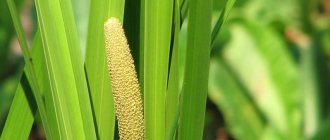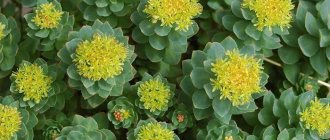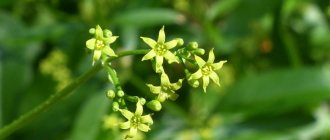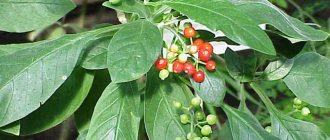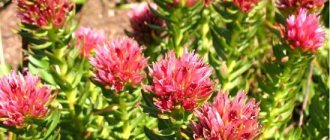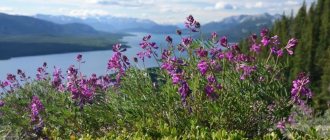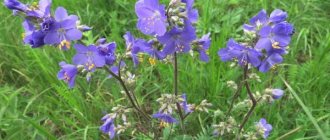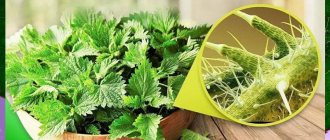People call marshmallow differently: marshmallow, wild rose, kalachiki, mucus grass. This plant is distributed almost throughout the planet, and it is not surprising that in each region this medicinal herb is called differently. But many names are not the only feature of marshmallow. Much more impressive is the list of beneficial properties that have been attributed to this herb since the 9th century BC. This plant was cultivated by the ancient Greeks and Romans, who gave the plant its name - Althaea, which means “to heal.”
Althaea officinalis. Kinds
The marshmallow genus includes 17 species, including:
- Armenian marshmallow – Althaea armeniaca;
- marshmallow hemp – Althaea cannabina;
- hard-haired marshmallow (rough) – Althaea hirsuta;
- Ludwig's marshmallow – Althaea ludwigii, etc.
Some of them, such as Armenian marshmallow, also have medicinal properties.
Latin name for marshmallow : Althaea officinalis L.
Other names: marshmallow, marshmallow root, marshmallow grass, mallow, mallow, wild poppy, gingerbread, rolls, pharmaceutical rolls, marshmallow, wild rose, slug, erysipelas, wild erysipelas, poppy, etc.
What do the doctor's say
According to doctors, wild rose rhizome is a good medicine. It is recognized not only by herbalists, but also by official medicine. It is not for nothing that the name itself - marshmallow - is given from the Greek althos - doctor.
Experts say that with judicious use of herbal remedies, the likelihood of side effects is reduced to almost zero. But do not forget about the main dangers of such therapy:
- Allergy. It doesn’t happen often, but it’s impossible to predict its absence. Therefore, people with an increased tendency to allergic reactions are advised to refrain from treatment with this plant. For everyone else, it is important to conduct an allergy test 24 hours before the start of treatment, if you have not used flora before. The test is carried out as follows: the drug is applied to the skin on the inside of the elbow, and the application site is observed for a day. If there is no discomfort, you can continue treatment.
- Compatibility with other medications. Mucus slows down the absorption of any other medicine and prolongs its effect. Therefore, you need to combine marshmallow with other remedies carefully and carefully. It is best to do it under the supervision of a doctor.
Althaea officinalis. Botanical description
Althaea officinalis is a herbaceous perennial. Height: 100-120, up to 150 cm. The rhizome is short, multi-headed, often simple, but can also branch. The main root is large (up to 2 cm in diameter), woody, and gradually becomes thinner. The lateral ones are numerous, fleshy, thick, smooth. Color: brownish, brownish-yellow.
The stems are vertical, cylindrical, often several, in the form of a bush, weakly branched in the flower part. Woody at the base, glabrous, succulent at the top, covered with gray star-shaped soft-felt hairs. The color is dirty purple at the base and green at the top.
The leaves of marshmallow are alternate, ovate, oblong-ovate, three to five lobed, unevenly serrate, softly and densely pubescent, velvety. They are located on long petioles. Color: grayish green. Length: 3.5-20 cm.
The flowers are large, the calyx is five-lobed, double, on short pedicels. They are located several in the axils of the upper leaves and at the top of the stems, forming spike-shaped inflorescences. Diameter: 20-30 mm. Color: hot pink, pale pink, white.
The fruit is small, flat, disc-shaped, and when ripe, breaks up into individual smooth kidney-shaped achenes (15-25 pcs.). Colour: dark grey. Weight of 1000 seeds – 2.0-2.7 g.
Marshmallow blooms from the second year, in June-September. The fruits ripen in August-October. Propagated mainly by seeds, less often by dividing rhizomes.
Problems during cultivation
Althea is resistant to diseases and pests, but can occasionally be damaged by soil insects. If wireworms, chafer larvae are found in the root zone, and cutworms and weevils are found on the leaves, then all above-ground parts should be treated with pyrethrum. Application rate – 2 g/m2.
Sometimes there is no flowering. This may be due to the fact that the plant is still too young or already very old. In the first case, you should wait another year, and in the second, you should propagate old specimens by dividing the rhizomes or sow fresh seedlings.
Althaea officinalis. Habitat
Althaea officinalis is common in Syria, Iran, Afghanistan, Kashmir, and Northeast Africa. And also in the middle and southern zone of the European part of the CIS, in Ukraine, Belarus, Crimea, the Caucasus, the Volga region, Eastern and Western Siberia, Central Asia.
Where does marshmallow grow? The plant prefers fertile, sandy, loamy, moist and loose soils. It can be found along the banks of water bodies (rivers, lakes, swamps, etc.), in wet meadows, the outskirts of alder and other wet forests, among bushes, in vegetable gardens, near fences, and near roads. Forms groups, sometimes sparse thickets. Due to its decorative properties, marshmallow grows in courtyards, flower beds, and flower beds.
In some countries, including the CIS countries, Europe, and the USA, the plant is grown on an industrial scale.
Althaea officinalis. Collection and preparation
For medicinal purposes, the roots are often harvested, and less often the leaves and flowers. Harvesting the roots of marshmallow is done in late autumn, when the herbaceous above-ground part dies off, or in early spring before the greenery grows back. When harvesting, about 30% of the plants should be left for restoration. In the same place, repeated harvesting can be carried out after 3-4 years.
The roots are cleared of soil, the aerial part is cut off, as well as the lignified and capitate parts of the rhizomes, leaving root growths, and quickly (20-25 minutes), to avoid sliming, they are washed in running water. Then they are cut into pieces 20-25 cm long, and with a thickness of over 1.5 cm, also lengthwise.
Drying marshmallow is carried out first in the open air, and then dried in a room with good air ventilation, preferably on nets, spreading it loosely in a thin layer, not forgetting to stir often. Marshmallow root is hygroscopic, easily becomes damp, molds and rots, and for high-quality drying it is better to use special dryers. Well-dried roots break with a bang.
During the summer, marshmallow leaves and flowers are harvested. In order not to disturb the growth of the plant, you should not tear off all the leaves on it at once. Dry as usual.
Finished raw materials are stored in cardboard boxes or bags made of natural material in a cool, dry place with good air ventilation. The shelf life of marshmallow is 3 years.
Althaea officinalis. Chemical composition
Beneficial and medicinal properties, as well as application, depend on the chemical composition of marshmallow. All parts of the plant contain large quantities of mucous substances: roots - up to 35%, leaves - up to 12.5%, flowers - up to 5.8%, represented mainly by polysaccharides that decompose during hydrolysis into galactose, arabinose, pentose and dextrose.
In addition, starch (35-37%), pectin (10-11%), sucrose (up to 10.2%), betaine (4%), asparagine (2%), lecithin, phytosterol, fatty oils (up to 1.7%).
Among the vitamins, carotene is present. Marshmallow root is a storehouse of macro- and microelements: potassium (11.30 mg/g), calcium (17.40 mg/g), magnesium (4 mg/g), iron (0.73 mg/g), and manganese (0.10 µg/g), copper (0.47 µg/g), zinc (0.25 µg/g), cobalt (0.10 µg/g), chromium (0.10 µg/g), aluminum (0.46 µg/g), vanadium (0.29 µg/g), nickel (0.15 µg/g), iodine (0.10 µg/g), boron (0.20 µg/g), etc. .
Marshmallow leaves contain essential oil (0.02%), rubber-like substances, vitamins ascorbic acid, carotene.
Content
- 1 Title
- 2 Distribution and ecology
- 3 Botanical description 3.1 Appearance
- 3.2 Leaves
- 3.3 Flowers
- 3.4 Fruits and seeds
- 4.1 Collection and drying
- 5.1 Medical use
Althaea officinalis. Application in folk medicine
A large number of people, freely using plants to treat various diseases, believe that they are absolutely harmless. However, among medicinal plants there are potent, toxic and even poisonous ones. In addition, many people, especially older people, have several chronic diseases.
Therefore, in order for the treatment to be effective, when using it, one should take into account the beneficial and medicinal properties of marshmallow and the contraindications that it can cause if used incorrectly, and this can only be done by a doctor. Based on this, before you start taking plant preparations, consult a doctor, or better yet, a herbalist you trust. The information given below is for informational purposes only.
Colds and bronchopulmonary diseases
Both official and traditional medicine recommend the medicinal properties of marshmallow for various diseases of the respiratory system. How to take marshmallow?
Plant preparations (decoction of roots, infusion of flowers/leaves, syrup, juice) thin mucus well, have an expectorant effect, and relieve inflammation. Based on this, marshmallow is used for coughs, whooping cough, bronchitis, bronchiectasis, bronchial asthma, pneumonia, pneumonia, tuberculosis, as well as catarrh of the throat and respiratory tract. Marshmallow combines well with other medicinal plants in breast teas.
Also, infusions and decoctions are used for rinsing for inflammation of the tonsils, soft palate, sore throat, etc. An infusion of flowers is used for rinsing the nose with a runny nose and ulcers, as well as for preventive purposes.
Gastrointestinal diseases
The benefits of marshmallow for the stomach and intestines are great. Plant preparations are recommended for gastritis, gastric and duodenal ulcers, colitis, enterocolitis, rectal diseases, dysentery, diarrhea, including dyspeptic diarrhea in children, etc.
The mucus of the plant, acting as an enveloping agent, covers the mucous membrane, relieves inflammation, and promotes natural tissue regeneration. In addition, the absorption of various soluble drugs slows down, thus increasing the time of their exposure to the affected surface. This effect is of great help in various food poisonings as first aid.
An infusion of marshmallow leaves is used for enemas.
For the liver
Traditional medicine recommends marshmallow for the treatment of jaundice.
Kidney and bladder diseases
As a remedy, marshmallow has proven its effectiveness in diseases of the kidneys, bladder and urinary tract, primarily in relation to various inflammatory processes. A decoction (infusion) of the roots is prescribed for cystitis, urolithiasis, painful and involuntary urination, and catarrhal phenomena in the urinary tract.
In case of urinary retention, both internal intake and compresses are applied to the lower abdomen using marshmallow decoction.
For women
The benefits of marshmallow have found their application for women. For these purposes, a decoction of the roots is most often used. So it is prescribed for douching for leucorrhoea. To enhance the effect, add a decoction of oak bark to the marshmallow decoction in a 1:1 ratio.
For inflammation and ulcers on the genitals, the plant is recommended for washing.
Marshmallow is also used in cosmetology. In case of inflammation of the facial skin, wipes soaked in the broth are applied to the sore spots. Exposure time 5-10 minutes.
For men
For diseases of the male genital area, such as prostatitis, including chronic prostatitis, prostate adenoma, marshmallow preparations are taken orally, and compresses are also applied to the lower abdomen.
Oral diseases
Due to its anti-inflammatory properties, marshmallow is used for rinsing the mouth during inflammatory and ulcerative processes.
Eye diseases
In folk medicine, marshmallow (root, flowers) is used as a wash for inflammatory processes of the mucous membrane of the eyes, rotting of the eyelids, and blepharitis. For the same purposes, the juice of the aerial part is used.
Also, lotions made from a decoction of marshmallow root have a good effect. The duration of the procedure is 5-10 minutes.
Skin diseases
The medicinal and beneficial properties of marshmallow have proven themselves well for various skin pathologies, such as eczema, lichen, psoriasis, skin itching, scabies, allergic dermatoses, furunculosis, pustular diseases, etc.
For these purposes, apply lotions to the affected surface with a decoction of marshmallow root. The juice of the plant is used for lubrication.
Skin damage
Plant preparations are effective for treating certain injuries and damage to the skin. How to take marshmallow in this case? In case of inflammatory processes of the skin, washes are carried out and lotions are applied from a decoction (infusion) of the roots. For muscle inflammation, a compress should be made from warm liquid. Also, lotions help with bruises, swelling from blows, and injuries.
A decoction of the roots is also used for burns. For the same purposes, juice is used to lubricate the damaged surface.
Joint diseases
A poultice for radiculitis is made from a decoction of marshmallow roots.
Althaea officinalis. Dosage forms
Based on marshmallow, the pharmaceutical industry produces drugs that can be bought at pharmacies:
- dried marshmallow root extract,
- liquid marshmallow root extract,
- marshmallow syrup,
- dry cough syrup for children,
- Mucaltin tablets,
- Paracodine syrup,
- as part of breastfeeding fees, etc.
Some of them can be prepared at home.
Root decoction
2 tbsp. pour 200 ml of marshmallow roots. water, bring to a boil and simmer over low heat for 30 minutes. Remove from heat, cover with a lid, insulate and leave for 10 minutes. Strain. Using boiled water, bring the resulting broth to its original volume. Store in a cool place for no more than 2 days.
Take 0.2-0.3 tbsp. 3-4 times a day before meals. To enhance the effect, add 1 tsp. honey
Classification
Althaea officinalis species
is part of the genus
Althaea
of the tribe
Malveae
of the subfamily
Malvoideae
Malvaceae
family of the order
Malvales
.
| 10 more families (according to the APG II System) | 6-12 more species | ||||||||||||
| order Malvaceae | genus Altheus | ||||||||||||
| Department Flowering, or Angiosperms | Malvaceae family | species Althaea officinalis | |||||||||||
| 44 more orders of flowering plants (according to the APG II System) | more than 200 more births | ||||||||||||
Althaea officinalis. Traditional medicine recipes
Extract
To prepare the marshmallow root extract, use a decoction, which is poured into a container, brought to a boil and simmered over low heat until the volume of the liquid is reduced by half.
Take 2 tsp. 3 times a day before meals.
Marshmallow syrup
Boil sugar syrup at the rate of 64 parts sugar and 35 parts water. Add 4 parts of marshmallow root extract to the boiling syrup (see recipe above). Boil. Remove from heat, cool.
Take marshmallow syrup 0.5 tbsp. 3 times a day.
Juice
To prepare the juice, marshmallow grass collected during flowering is used. The raw materials are washed well under running water and crushed using a meat grinder or blender. The juice is squeezed out of the resulting mass using gauze.
Take 1 tbsp. (can be mixed with 1 tsp honey) 3 times a day before meals.
The juice is recommended as an expectorant and anti-inflammatory agent.
Good to know…
- Rose marshmallow (more often called mallow) is grown as an ornamental plant. It has a similar effect on humans, but less pronounced.
- The stems contain cream-colored fibers that are quite short and coarse, which are of no practical use but can be used to make rope and paper.
- Marshmallow roots are eaten raw and boiled, and jelly and porridge are prepared from them. In ground form, they are added to baked goods.
- Marshmallow flowers and grass contain a pigment - malvidin, which gives the wool a red color, with iron salts it gives a blackish-blue or gray color, with aluminum salts - gray or grayish-violet, and with tin salts - dark purple.
- Fatty oil from marshmallow fruits is used in the paint and varnish industry, and the roots are used to make glue.
- Althaea officinalis is a honey plant.
Althaea officinalis. Contraindications
In order for the treatment to be beneficial, it is necessary to take into account the medicinal and beneficial properties of marshmallow and the contraindications that it has. The plant should not be taken if:
- advanced varicose veins,
- thrombophlebitis.
Long-term use of marshmallow preparations is not advisable during exacerbation of pancreatitis or diabetes mellitus.
Sources: Advice from the traditional healer Evdokia. Herbalist, illustrated reference book.
Rim Akhmedov. Plants are your friends and foes.
V.V. Reshetnyak. Herbalist. G.N. Kotukov.
Cultivated and wild medicinal plants.
I.N. Putyrsky, V. Prokhorov. Universal encyclopedia of medicinal plants.
A.P. Popov. Medicinal plants in folk medicine.
S.Ya. Sokolov, I.P. Zamotaev. Handbook of medicinal plants.
M.A. Nosal, I.M. Nosal. Medicinal plants and methods of their adoption among the people.
A.K. Bondarenko, V.G. Forelock. Medicinal plants of the south of Ukraine. Procurement, reproduction, application.
D.S. Ivashin, Z.F. Katina. Medicinal plants of Ukraine.
Name
The Latin name of the genus comes from the Greek. Althaca - “to heal” - this is the name of the plant used by Theophrastus, Dioscorides and Pliny[3].
Folk names in Russian and a number of other languages:[4][5]
- in Russian - marshmallow, mallow, marshmallow, kalachiki, wild rose;
- in Belarusian - althea;
- in Ukrainian - marshmallow likarska, marshmallow, mug, proud, kalachiki, palyanitsya, patsіrnik, patsurnik, proskuren, proskurki, dog, ruzha psyacha, tears;
- in Polish - Prawoślaz lekarski;
- in English - marshmallow, marsh mallow, white-mallow;
- in French - guimauve officinale, guimauve sauvage;
- in German - Eibisch, Echter eibisch;
- in Spanish - malvavisco;
- in Georgian - ტუხტი (tukhti)
; - in Abkhazian - amalykhә;
- in Kyrgyz - koroz-gul;
- in Azerbaijani - Aptek gülxətmi, Dərman bəlğəmotu.
